
SANI MONASTERY
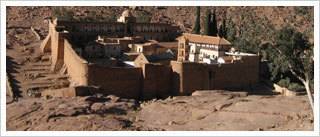
Emperor Kanishka (Aka Kanika) had got 108 chortens constructed in the first century AD One of them is in Sani. The holy site at Sani is called Turtot Gyat and is one of the 8 holiest Buddhist sites in the world. That is why most of the Luminaries of Himalayan Buddhism including Padma Sambhava, Naropa and Marpa have visited Sani. This venerable monastery had ancient and medieval frescoes.
RANGDUM MONASTERY
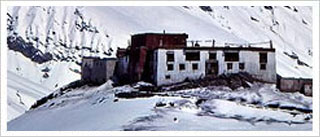
Rangdum: (3,657 meters, 130 km from Kargil town, 65 Km from Panikhar). The Rangdum monastery has tiny "museum" with interesting Tibetan and other artifacts. Around forty monks live in the gompa, It is difficult to agree with accounts that date the Gompa to the 8th century. 18th century is more likely. The villagers who live near the Gompa are basically the agriculture shrifts of the monastery, a guidebook informs us.
ZONGKHUL MONASTERY
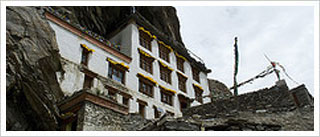
This monastery is built in a spectacular cave, lies on the Padum-Kishtwar trekking route, just before the ascent to the Omasi-La Pass begins. Situated like a swallow's nest on the rock face of the Ating Gorge, the monastery is associated with Naropa, a famous India Yogi. The two caves around which the present monastery has developed are said to have been used by Naropa for solitary mediation the frescos on the cave walls are very old and reflect a high degree of artistic achievement.
KARSHA MONASTERY
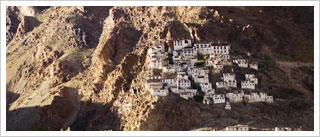
The largest monastic establishment of Zanskar, Karsha Gompa is an imposing complex of neatly white-washed adobe blocks comprising several chapels, besides residential rooms for its nearly 150resident monks. Karsha is 4-6 Km from Padum. Built picturesquely along the steep gradient of the mountainside above the Stod River, the monastery can be seen from far and wide. The Gompa, founded by Phagspa Sherab in the 11th century, has the largest library (Kahgyur Khang) in Zanskar and even beyond; there are eight temples and two assembly halls in the complex, which also houses a famous, large and priceless Thangka and smaller but valuable scrolls and precious idols.
The Thabrang (room of God and religion) has frescoes dating back to around the 15th century. There is a 14th century Chomo Gompa (Nunnery) called the Dorje Dzong at the other end of Karsha. The nuns go over to the main Gompa for all major festivals. Karsha is the biggest and richest monastery in all Zanskar.
STONGDAY MONASTERY
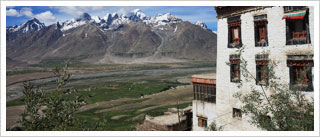
Stongday Gompa is built on a rocky outcrop overlooking the oasis-like village below. It lies 20 Km to the north of Padum, on the road leading to Zangla. Stongday is now the second largest monastic establishment of Zanskar with 60 resident Gelukpa monks. The highlight of this monastery is its Gon Khang (temple of guardian deities).
PHUKTAL MONASTERY
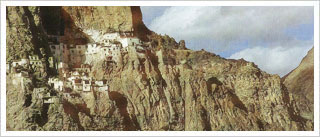
Phugthal is the most spectacularly located monastic establishment anywhere in Ladakh. The Phugthal complex spills out of the mouth of a huge cave high up in the sheer mountain face of a lateral gorge through which a major tributary of the Lungnak River flows. Perhaps the most isolated monastery in Zanskar, its foundation dates back to the early 12th century. The monastery has frescos and ceiling decorations reflecting strong Indian artistic and oceanographic influence.
ZANGLA
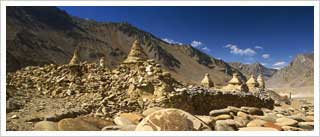
Zangla is 35 km from Padum. The Zanskar River, which leads from Padum to Zangla and then Leh, freezes so hard in the winters that for a few weeks one can walk on it. This is known as the chaadar. The trek from Padum to the motorable road in Leh district can take a week. There are little caves by the frozen river in which travelers' camp at night. Zangla is base camp for in which travelers camp at night. Zangla is base camp for trekkers in the summers. There is a nunnery nearby. There are no formal hotels in the village, but some families take in guests.
SHARGOLE MONASTERY
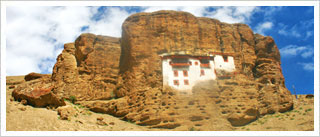
Shargole is another 10 Kms ahead of Mulbekh, or 35 km, before Kargil, it's small but old Ge-Lugs Pa Buddhist monastery has fellow but interesting frescoes. Inside the Gompa is an icon of an Avalokiteswar. There in the Gompa is also three images of Tara, caved in wood by Tibetan artists. It just out of a brown, granite cliff and appears as if it is suspended in the middle of the mountain. This architectural quirk makes it an object of curiosity among local people, too. The panoramic view from the verandah of the "cantilever monastery" is stunning and helps the worshipper concentrate better There is a tiny Buddhist nunnery below.